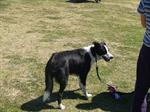How to Train Dogs

The behaviour of dogs has been studied by many specialists and experts over many hundreds of years.
Actions and reactions take place continuously. Actions and reactions are the result of complex biochemical signalling linked to genetics, physiology and the environment in which the dog lives. We merely mention the complex nature of dog behaviour (and psychology) in this lesson, but you should begin to make connections between the different aspects of dog care and training and link this to understanding of the nature of dogs.
Again considering pack mentality and your position within the pack as alpha, it is important that your dog only takes on your command or with your permission. Your dog should respect that he is not able to take or eat without the permission of the pack leader. Dogs need your leadership within the pack to be maintained. Your position as leader allows the dog to understand and accept its subordinate role and therefore relax and become a well-adjusted and happy dog. Consider the theory of leadership throughout any subsequent study in dog training and behaviour management.
GENERAL TRAINING
The Importance of Training
Basic training teaches dog’s good manners as well as reinforcing the owners/handlers position as both a carer and a voice of authority. It is important that appropriate training starts early in a dog’s life to establish firm boundaries and reinforce good behaviour from the start.
By teaching a young dog many basic commands, we are able to have control it. This is essential as it helps to protect the dog from the world which they are unaware of – such as running away or being struck by a moving vehicle, or into any dangerous situation, whatever it may be.
Behavioural training focuses on forming good habits, preventing bad habits and teaching a dog how to interact appropriately with other dogs. Obedience training is used to teach a dog basic commands like ‘sit’ ‘stay’ or ‘heel’. The most important things to remember when any type of training is carried out is to ensure all commands are clear, that they are repeated often and any good behaviour is quickly rewarded.
PRACTICAL TECNIQUES FOR OBEDIENCE TRAINING
The sequence in which these training commands are presented are the recommended order in which they should be followed within a training program.
Technique for Recall
- Call your dogs name to gain their attention.
- From an extended arm position, give a visual signal to “come” by moving you’re the palm of your hand towards you (low to the ground).
- Give the voice command “come” just as the dog starts moving toward you.
- When the dog is at you praise and reward by giving a small treat
- Repeat at least 12 twelve times.
It is important that the dog comes to you when called. Commonly we may call the dog by the name but this is not a command. A command is an instruction.
Technique for Sit (in front)
- Call your dogs name to gain their attention.
- With your hand, which is containing a small treat, place it in front of the dog’s nose.
- From a standing position, draw your hand upwards to waist height (your body should be upright).
- Your dog should naturally assume the sit position; as soon as it starts to move into the sit position give the “sit” command.
- Reinforce by giving the dog a small treat.
- Move your hand back into the position beside your waist.
Getting a dog to sit is one of the simplest dog training exercises and can be very achieved very early on in training.